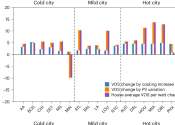Microsoft taking Xbox games directly to TVs
Microsoft on Thursday said it is working on software to let people play Xbox video games on internet-linked televisions without need of consoles.
Jun 10, 2021
0
4
Software

Microsoft on Thursday said it is working on software to let people play Xbox video games on internet-linked televisions without need of consoles.
Jun 10, 2021
0
4
Telecom

In a research letter published on July 11, 2023, in Geo-spatial Information Science, a research group led by Deren Li and Mi Wang from Wuhan University unveiled the LuoJia3-01, an experimental satellite that integrates state-of-the-art ...
Nov 30, 2023
0
1
Consumer & Gadgets

Climate change will increase the future value of residential rooftop solar panels across the United States by up to 19% by the end of the century, according to a new University of Michigan-led study.
Apr 19, 2024
1
15
Electronics & Semiconductors

The ever-increasing workload of data centers calls for new ways to store and access data. Researchers from the Daegu Gyeongbuk Institute of Science and Technology, Korea, have developed a new approach to manage databases ...
Aug 20, 2020
0
8
Internet

With each passing quarter, Amazon, Microsoft and Google have been setting new records, while cloud computing has become the invisible backbone supporting much of our daily lives. Its potential to become an even bigger part ...
Feb 16, 2020
0
18
Engineering

Scientists said Monday they have used a laser beam to guide lightning for the first time, hoping the technique will help protect against deadly bolts—and one day maybe even trigger them.
Jan 16, 2023
1
40
Software

Judging from technology-watching sites, Intel has something to worry about and it involves a rather well known place on the technology map called Redmond, Washington. Look for the sign that says Microsoft. There.
Robotics

Australian researchers have designed an algorithm that can intercept a man-in-the-middle (MitM) cyberattack on an unmanned military robot and shut it down in seconds.
Oct 12, 2023
0
87
Consumer & Gadgets

Google unveiled an experimental way to search the internet that gives more conversational results, and said its artificial intelligence chatbot, Bard, is now available for much of the world to use online.
May 11, 2023
0
15
Computer Sciences

Algorithms that help consumers decide what to stream or buy online can do more than predict customers' habits: They can help satellites see the Earth better, according to a Rutgers study.
May 11, 2022
0
62
A cloud is a visible mass of droplets or frozen crystals suspended in the atmosphere above the surface of the Earth or another planetary body. A cloud is also a visible mass attracted by gravity, such as masses of material in space called interstellar clouds and nebulae. Clouds are studied in the nephology or cloud physics branch of meteorology.
On Earth the condensing substance is typically water vapor, which forms small droplets or ice crystals, typically 0.01 mm in diameter. When surrounded by billions of other droplets or crystals they become visible as clouds. Dense deep clouds exhibit a high reflectance (70% to 95%) throughout the visible range of wavelengths. They thus appear white, at least from the top. Cloud droplets tend to scatter light efficiently, so that the intensity of the solar radiation decreases with depth into the gases, hence the gray or even sometimes dark appearance at the base. Thin clouds may appear to have acquired the color of their environment or background and clouds illuminated by non-white light, such as during sunrise or sunset, may appear colored accordingly. In the near-infrared range, clouds look darker because the water that constitutes the cloud droplets strongly absorbs solar radiation at those wavelengths.
This text uses material from Wikipedia, licensed under CC BY-SA